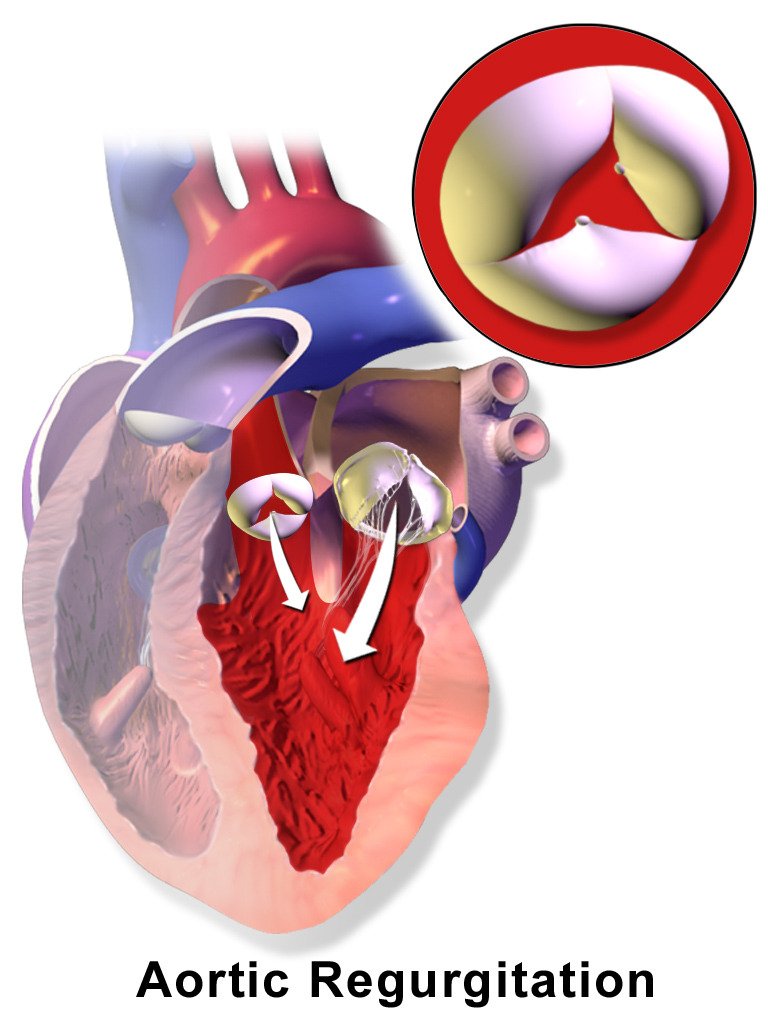Playlist
Show Playlist
Hide Playlist
Aortic Regurgitation: Introduction
-
Slides Valvular Heart Disease Aortic Regurgitation Cardiovascular Pathology.pdf
-
Download Lecture Overview
00:02 Aortic regurg is building of each one of these valvular heart diseases. As we go through each individual one, everything comes to light as it has been, hopefully. Once we are done discussing all valvular heart diseases, it is important that you keep going back and reviewing each one because it is easier otherwise to mix them up and you know exactly what I am referring to. With aortic regurg, the problem is blood is coming back from the aorta. 00:32 What I would like for you to do is think about the anatomy of arch of aorta, and it's coming back towards the left ventricle and when it does so, where is the best place that you might perhaps hear this murmur again? It was located in the third intercostal space and it will be the left parasternal. At least know that you are moving towards the apex. If by chance you don't find the third intercostal space left parasternal as being an answer choice you don't find that as being an option on a picture on your screen of a chest, then you move towards the apex. I hope that is clear. 01:07 That is the only way that you will get any of these questions right without causing further confusion. Ok. Once you are going to start bringing about regurg, completely different when compared to aortic stenosis. In what respect? In the respect of how the left ventricle is going to respond technically? Why am I saying that? Because the response overall granted whenever that the left ventricle is undergoing undue pressure either from volume or from pressure itself the left ventricle is going to undergo hypertrophy. Is that clear? So whenever the left ventricle is facing adversity it is going to try to adapt and rise to the occasion and with aortic stenosis did they undergo hypertrophy? Of course, they did. What did it do? It underwent concentric hypertrophy in which the sarcomere is duplicating in parallel, in which will eventually may result in diastole dysfunction but my goodness you do not want to get your patient to the point where such heart failure is taking place. Remember the rule of 5,3 and 2 with aortic stenosis. So, here with aortic regurg, it is as fact the left ventricle is facing pathology or adversity with the volume. So does that mean it will undergo hypertrophy? Of course, it will but this type of hypertrophy is one in which the sarcomeres are not going to duplicate in parallel, they are going to duplicate in a series and you call this eccentric type of hypertrophy. Now, what is interesting about is can you use the same concept towards congestive heart failure? Of course, you can. In congestive heart failure, there is going to be volume overload there as well, but that has nothing to with aortic regurg per se but that volume overload may result in hypertrophy, an eccentric type and what is the state of your heart? Cardiomegaly, lateral displacement of your PMI, point of maximum impulse. Now, with all that said let us take a look at acute and chronic changes. In acute changes, all those blood is coming into the left ventricle and my goodness the pressure is going to start increasing like crazy early on. And then, at some point, chronically, take a look at the size of left ventricle, it is enlarged. Is it hypertrophy? Yes, it is. Compare. It is thickened but it's not concentric, this is eccentric. Now how is the patient going to present? So now we have all this blood coming back in the left ventricle but this time, do you have any problem with opening the aortic valve? No problem. 03:46 It just wants to open as freely as that and so with that free opening of the aortic valve with no resistance at all basically, you have increased amounts of blood that is now being pushed out during systole towards the systemic circulation. Tell me about some of that systemic circulations well up into the head. So you might find bounding pulse in the carotid. Bobbing of the head. Musser's sign. Might go to the radial, the bounding pulse is there. 04:15 You will have a water hammer pulse. You will have a bunch of those pulses that we will look at clinically at the end, understand the concept first and there are a couple of other things that we need to walk you through for pathophys and you have gotten every single concept right. 04:29 Let us take a look. Aortic regurg. Abnormality of backward flow.
About the Lecture
The lecture Aortic Regurgitation: Introduction by Carlo Raj, MD is from the course Valvular Heart Disease: Basic Principles with Carlo Raj.
Included Quiz Questions
Which of the following mechanisms is responsible for the "water hammer pulse" and bobbing of the head seen in aortic regurgitation?
- Increased stroke volume
- Decreased stroke volume
- Difficulty in the opening of the aortic valve
- Arrhythmia
- Congestive heart failure
Which of the following statements is FALSE regarding aortic regurgitation?
- Volume overload leads to concentric hypertrophy of the left ventricle.
- Volume overload leads to eccentric hypertrophy of the left ventricle.
- The pulse pressure is increased.
- Increased stroke volume leads to bounding pulses.
- There is difficulty in closing a stiff aortic valve.
Customer reviews
5,0 of 5 stars
| 5 Stars |
|
5 |
| 4 Stars |
|
0 |
| 3 Stars |
|
0 |
| 2 Stars |
|
0 |
| 1 Star |
|
0 |




